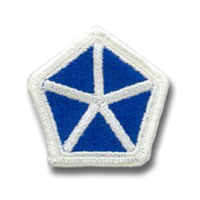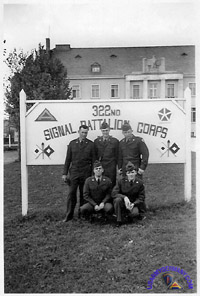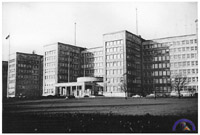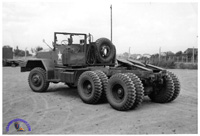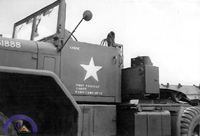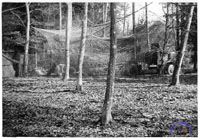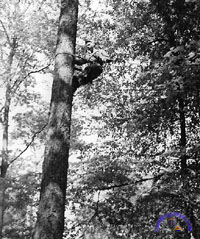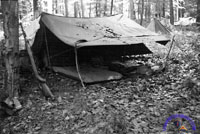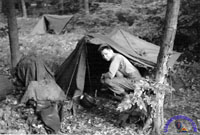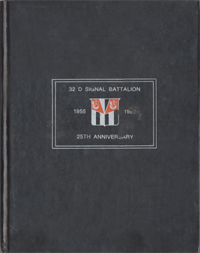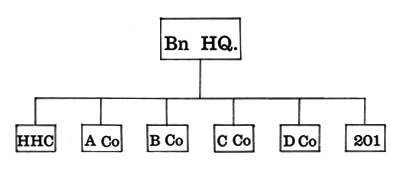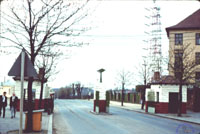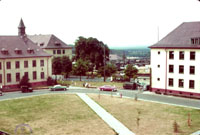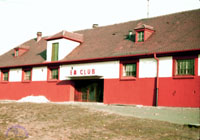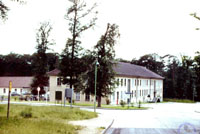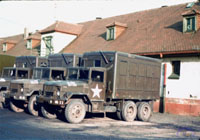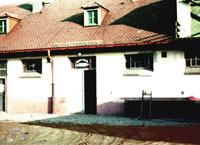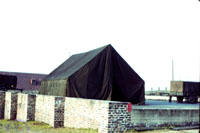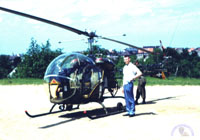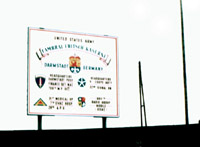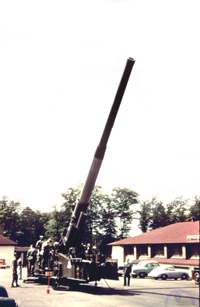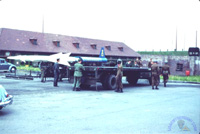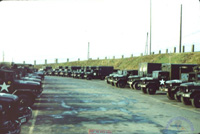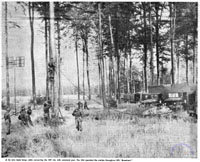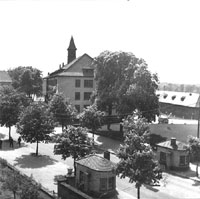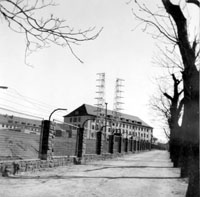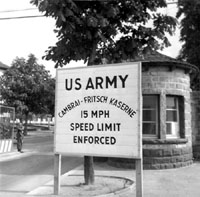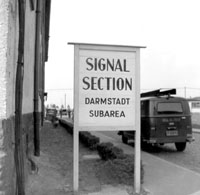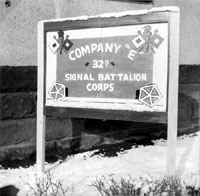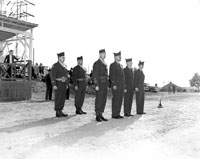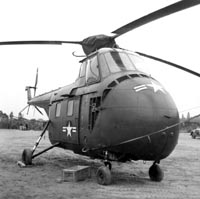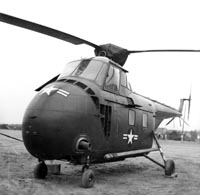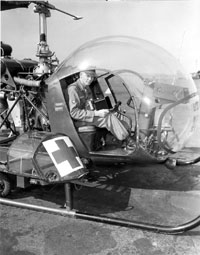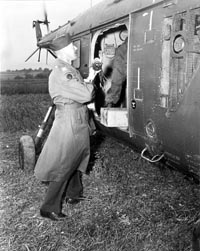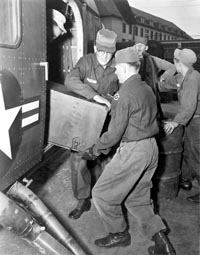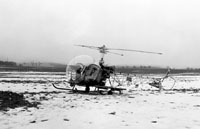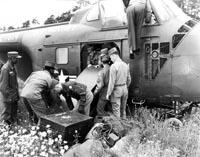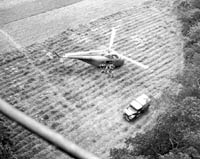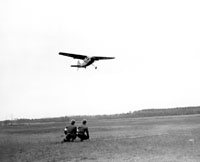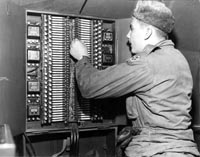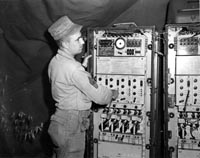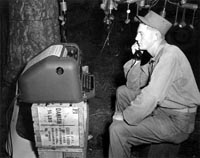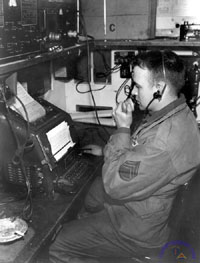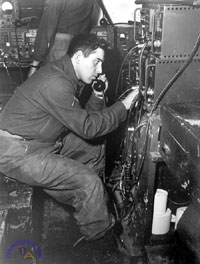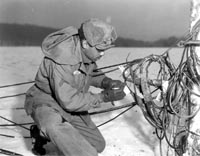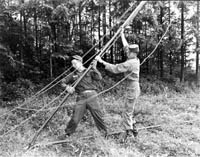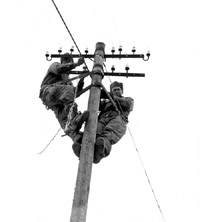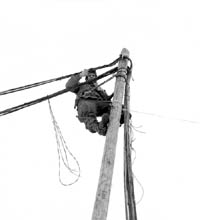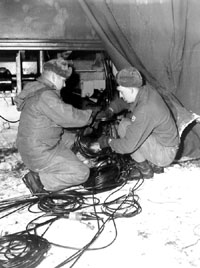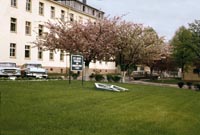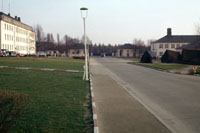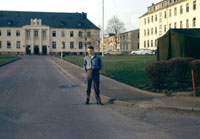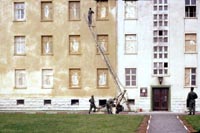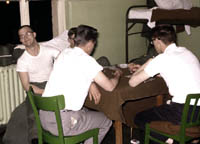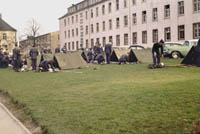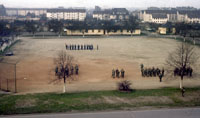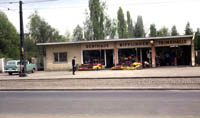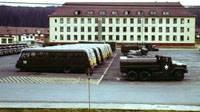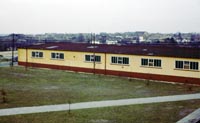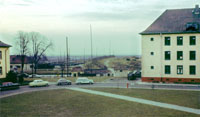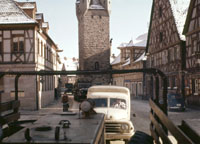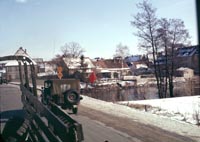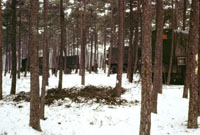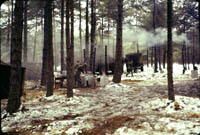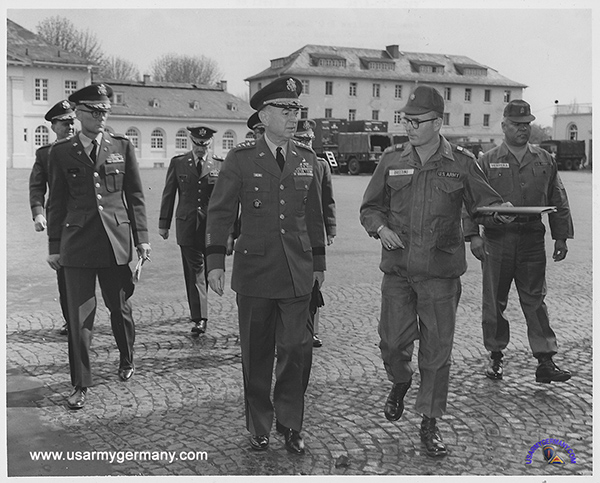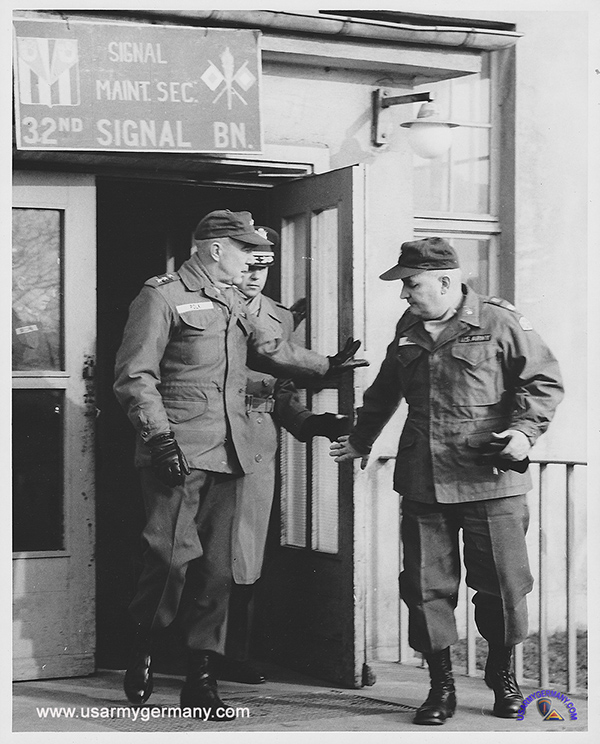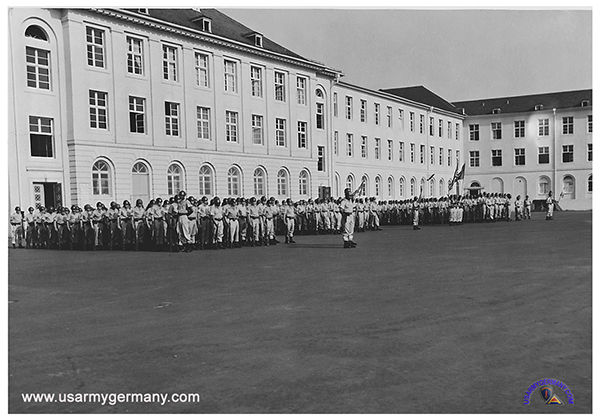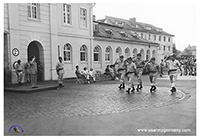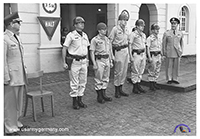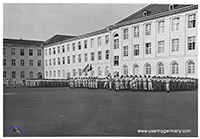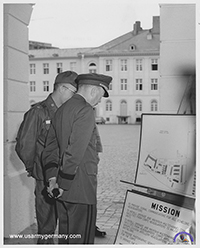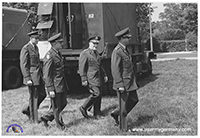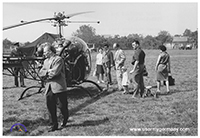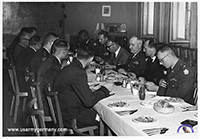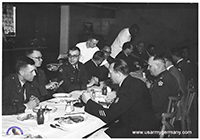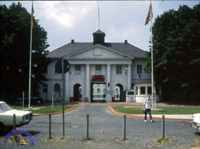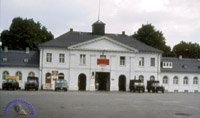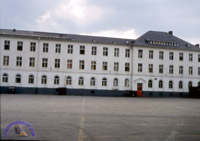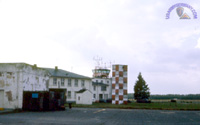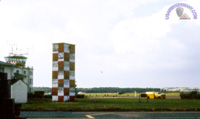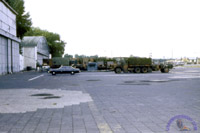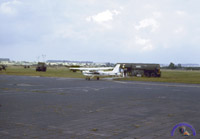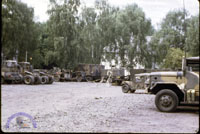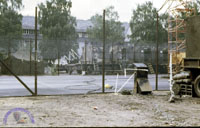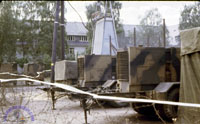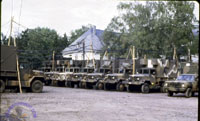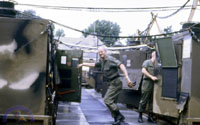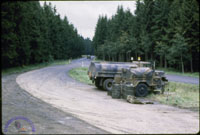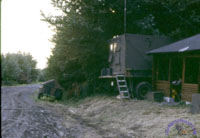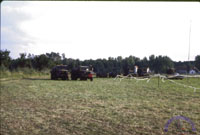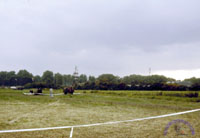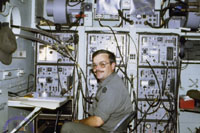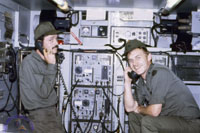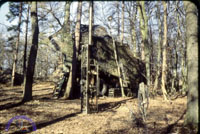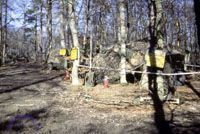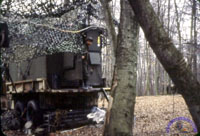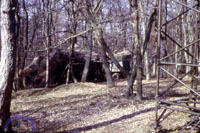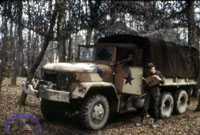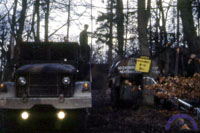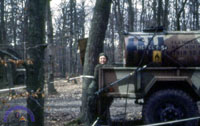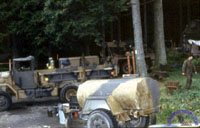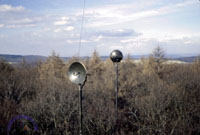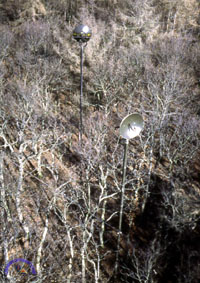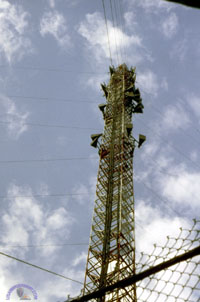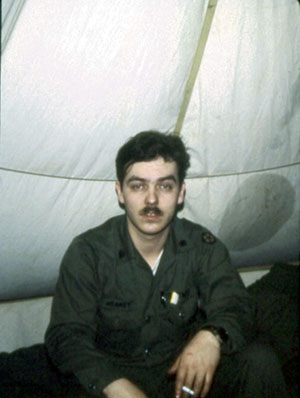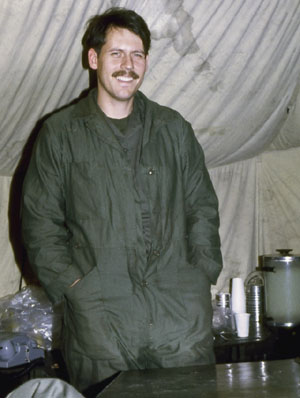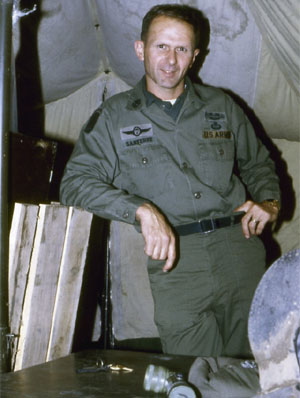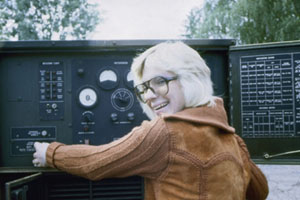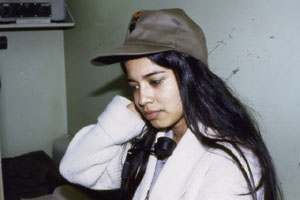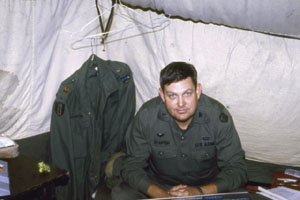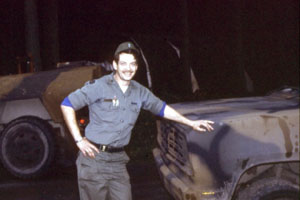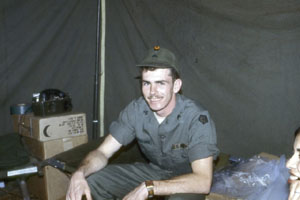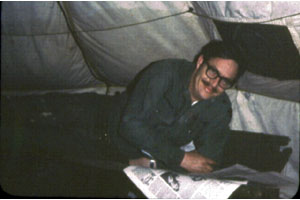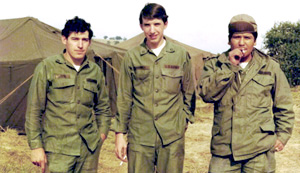| If you do
NOT see the Table of Contents frame to the left of this page, then
Click here to open 'USArmyGermany' frameset |
||||||||||||||||||||||||||||||||||||||||||||||||||||||||||||
32nd Signal Battalion |
||||||||||||||||||||||||||||||||||||||||||||||||||||||||||||
|
|
||||||||||||||||||||||||||||||||||||||||||||||||||||||||||||
|
||||||||||||||||||||||||||||||||||||||||||||||||||||||||||||
|
|
||||||||||||||||||||||||||||||||||||||||||||||||||||||||||||
| 322nd Signal Battalion History | ||||||||||||||||||||||||||||||||||||||||||||||||||||||||||||
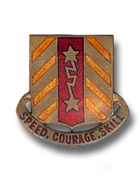 322nd Signal Bn DI 322nd Signal Bn DI |
||||||||||||||||||||||||||||||||||||||||||||||||||||||||||||
| 1951 | ||||||||||||||||||||||||||||||||||||||||||||||||||||||||||||
| (Source: STARS & STRIPES, December 4, 1951) | ||||||||||||||||||||||||||||||||||||||||||||||||||||||||||||
| The 322nd Signal Battalion is a California Army Reserve unit that is now stationed in Frankfurt (Gibbs Kaserne). The Bn provides a complete communications setup for V Corps. CO of the Bn is Lt Col Charles E. Roberston. The battalion operates a radio relay network, teletype, and telephone facilities, augmented with carrier equipment, message center, and heavy signal construction. MISCELLANEOUS Hq & Hq Co, 322nd Sig Bn Co A, 322nd Sig Bn Co B, 322nd Sig Bn Co C, 322nd Sig Bn Telephone & Teletype Co, 322nd Sig Bn Radio & Message Center Co, 322nd Sig Bn CO of 322nd Sig Bn (Oct 1952), Lt Col Charles E. Roberston, was replaced by Lt Col Edward C. Coffin. |
||||||||||||||||||||||||||||||||||||||||||||||||||||||||||||
| 1953 | ||||||||||||||||||||||||||||||||||||||||||||||||||||||||||||
| (Source: STARS & STRIPES, September 22, 1953) | ||||||||||||||||||||||||||||||||||||||||||||||||||||||||||||
| The 322nd Signal Battalion (arrived in Europe and joined) V Corps in December 1950. The battalion is currently stationed at Cambra-Fritsch Kaserne in Darmstadt. (Webmaster note: The battalion moved from Frankfurt to Darmstadt sometime late 1952.) |
||||||||||||||||||||||||||||||||||||||||||||||||||||||||||||
| (Source: Email from John Raquet, 322nd Sig Bn) | ||||||||||||||||||||||||||||||||||||||||||||||||||||||||||||
| I’ve sent you a picture I took at the entrance to the Giessener Strasse Kaserne in Frankfurt, Germany. We called it the Giessener Strasse Kaserne but it might be known by another name. I don’t seem to find it in your web site. I do find a Clarke Kasserne located on Giessener Strasse. Can’t find a picture of that one but that could be where I was. No such sign existed then, only the one in the picture. The year would have been 1953. Of the men in the picture, I can only identify one of them. The tall guy in the back row was my roommate, Gerald Lanham. I’ve got names for the others, I think, but can’t match the faces. A little background on the 322nd Signal as I remember it. The 322nd served as the communication facility for the US V Corps. In part, V Corps consisted of the 4th Infantry Division, in Frankfurt; Second Armored Division in Mainz. There were others, of course, but these are the only ones that come to mind. The battalion itself was stationed in Darmstadt, Germany. The picture of the Farben building. I don’t know whether you can see it or not but there was shrapnel damage to the outside of the building. We were told that the building was deliberately spared because the allies knew they would be using it at some later date. Inside the building they have a very unusual type of elevator. What it amounts to is cubby holes a little bigger that a telephone booth that are mounted on some kind of mechanism. Inside dimensions are about 5 feet square by 7 feet high. These cubby holes go around and around. They are open on the side that faces the floor you are on. No door. As they floor of the box comes about even with your floor, you simply step in. When you arrive at the floor you want, you simply step out. They never stop moving. I know a fellow that was over there in the last few years and he told me that they still use that system. He says a lady was killed trying to get on the thing. Things are different in Germany. (Webmaster note: for more info on the paternoster lift see the Wikipedia entry for the IG Farben Building.) The Message center was in the basement. It consisted of the message center itself and the code, or cryptography, room. This room was a locked room and only authorized personnel were allowed in it. You had to have at least a top secret security clearance to get in there. That is where I worked. I came back from Europe on a ship named Clark. I think it was the William B. Clark. When we got off the train in Bremerhaven, they marched us down the wharf and as we looked at the ships in port the first one we saw was the “SS United States.” Everyone was thinking that we were going home on the States. That would have meant about a 5 day trip. We just kept on marching and ended up on the Clark. It took the Clark 2 weeks, almost, to make the same trip. At sea on the Clark, Thanksgiving Day, 1953, we were in the most terrible storm. They said later that the waves were 61 feet high. They put the turkey and dressing in trays that were put on steam tables and kept warm with hot water. We rolled so bad that the water pushed the trays off the tables onto the deck. We ended up with baloney and cheese sandwiches for thanksgiving dinner. |
||||||||||||||||||||||||||||||||||||||||||||||||||||||||||||
| 32nd Signal Battalion History | ||||||||||||||||||||||||||||||||||||||||||||||||||||||||||||
| 1955 - Present | ||||||||||||||||||||||||||||||||||||||||||||||||||||||||||||
| (Source: 32nd Signal Battalion website) | ||||||||||||||||||||||||||||||||||||||||||||||||||||||||||||
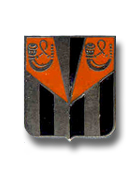 32nd Signal Bn DUI
32nd Signal Bn DUI On 28 January 1955, the 32d Signal Battalion (Corps) was reactivated at Cambrai-Fritsch Kaserne, Darmstadt, Germany under V Corps, USAREUR. The old 322d Signal Battalion, a reserve unit which had been serving as the corps signal battalion for V Corps ever since the Corps arrived in Germany during the augmentation period, was inactivated and the men and equipment were transferred to the newly activated 32d Signal Battalion (Corps). Since that time, the 32d Signal Battalion has provided critical communications support for every field exercise in which V Corps has been involved. When the Battalion was re-organized under the Delta Series TOE, in October 1961, the Battalion's cable construction capability was eliminated. The Battalion increased in size from 3 to 5 companies under USAREUR General Order 381 on 21 May 1961. In March 1964, after spending nine years in Darmstadt, USAREUR moved the Battalion to McNair Kaserne in Hoechst, Germany, just outside Frankfurt. On 26 June 1969, the 201st Signal Company was attached to the Battalion by V Corps General Order 139, bringing the number of assigned personnel over 1000. On 16 March 1981, the 32d Signal Battalion (Corps) was split into a Command Operations Battalion, designated the 17th Signal Battalion (Command), a Corps Radio Battalion, designated the 32d Signal Battalion (Radio) and a new Brigade Headquarters, the 22d Signal Bde, under whose command structure the two Battalions now fall. The 32d Signal Battalion (Radio) had four companies which provided the command multi-channel radio systems, radio-teletype and FM in support of V Corps. In June 1986, the 32d Signal Battalion (Radio) was re-organized as a corps-area Battalion and re-designated the 32d Signal Battalion (Area). In addition to providing command multi-channel and radio-teletype support, the Battalion now also provided three Corps Area Signal Centers, complete with automatic switching to support V Corps' tactical area of operations. From September through December 1990, the Battalion was re-organized as a Corps MSE Battalion, conducting a 100% swap-out of its equipment and re-activating D Company. The 32d Signal Battalion (MSE) consists of five companies, authorized over 600 personnel. The radio-teletype and cable installation capability of the Battalion was eliminated, but the capabilities gained with Mobile Subscriber Equipment are enormous. The Battalion's primary mission is to provide six MSE node centers for the Corps Area Support Network, one large extension node, and up to 40 small extension switches to support Corps units. In January 1992, the 32d Signal Battalion moved back to Darmstadt, to Kelley Barracks. From April to July 1999 the battalion deployed to Albania in support of Task Force Hawk and Operation Joint Forge during the Kosovo crisis. It continues to provide communications support for V Corps from the city where peacetime support began in 1955. On 22 March 1993, the 32d Signal Battalion was presented the United States Army Superior Unit Award for meritorious achievement. |
||||||||||||||||||||||||||||||||||||||||||||||||||||||||||||
| If you have more
information on the history or organization of the 32nd Signal Battalion,
please contact me |
||||||||||||||||||||||||||||||||||||||||||||||||||||||||||||
|
|
||||||||||||||||||||||||||||||||||||||||||||||||||||||||||||
| (Source: 32nd SIGNAL BATTALION (CORPS), 25th Anniversary Yearbook, 1955-1980) | ||||||||||||||||||||||||||||||||||||||||||||||||||||||||||||
|
||||||||||||||||||||||||||||||||||||||||||||||||||||||||||||
| 1955 | ||||||||||||||||||||||||||||||||||||||||||||||||||||||||||||
| (Source: Email from Lonis Wendt, D Co, 32nd Sig Bn, 1955-56) | ||||||||||||||||||||||||||||||||||||||||||||||||||||||||||||
I spent about 17 months in Delta Co. doing radio-teletype, field problems, and TDY duty with the French. I really liked my job there, as I was able to see and learn a lot about life which, at that time, I may never have experienced. We were headquartered at Darmstadt for my entire time there.
Our son is a Lt. Col. in the USAF and currently on active duty. While he was stationed at Rhein-Main in 1994, we took a 3 week vacation to Germany, combing a visit with our son, a return to Darmstadt and there to celebrate the 50th anniversary of D-Day. We visited the old barracks and the Kaserne, he and I had our picture taken looking out of my old room on 2nd floor.
I was kind of lucky, arrived as a PFC and was promoted to SGT (E-5) about two months before returning to the States. I received a commendation from the Colonel before leaving, and I still have it stored away in the bank lockbox, I do not know why I saved it.
A couple interesting things happened there while we were on one particular field trip. Some of us guys rigged up a method of long distance wireless voice communication by using two transmitters and two receivers whereby one of the Corps commanders calling from a great distance (much farther than the average 2-way radio communications of the day) could talk to another using wireless connections, heretofore we needed telephone lines, to make it operational for that distance, one guy had to flip a couple switches which controlled which receiver/xmitter was doing the transmitting or the receiving. At the time we thought it quite ingenious. And it was! The cellphone is a lot simpler!!! Another thing that happened there was the arrival of Elvis and Johnny Cash upon the stickbuddie scene. I was just trying to learn to pick the guitar a little, along with several other guys, and we had a lot of fun picking and grinning. Some of them guys became lifelong friends, TJ Stobbs to name one. I ended up picking well enough to have my own band for almost 40 years. We played a lot of basketball there, Gerry Lauford, Jerry Wilmot, Dave Parker, Ray Panirio, and several others were very good. Some of us were called to tryout for the V Corps team. I didn't go, I thought I was too short to make the team, however Gerry and Jerry both made the squad. Several guys were special friends, Jim Jones, Ray Wellman, Chuck McCollum, Ray Southern, Max Jones, and the little guy from NYC, Ron B. Rose, who did imitations of several famous people and kept us laughing a lot. I remember a little German waitress, "the Mouse" we called her, she was everybody's hearthrob and also quite friendly but it was strictly "hands off." I remember lots of pingpong tournaments and felt a lot of pressure to uphold my South Dakota country hick reputation. I suppose there were many other interesting events, but time has let them slip away, but really appreciate your keeping a history of the great 32nd. Sig Battalion. I always though Delta Co. had some very elite and capable, college educated GI's, I would think nearly everyone of them should have gone on to a reasonably successful life. |
||||||||||||||||||||||||||||||||||||||||||||||||||||||||||||
| (Source: Email from Jim Noble, D Co., 32nd Signal Bn. (Corps)) | ||||||||||||||||||||||||||||||||||||||||||||||||||||||||||||
| In Feb. 1956 our entire class (#29) of the Southestern
Signal School, Camp Gordon, GA. disembarked at
Bremerhaven and soon joined DOG Company of the 32nd as
teletype operators.
We were the teletype relay center stationed at
Cambrai-Fritsch Kaserne, Darmstadt while our message
center was in Frankfurt. While there we transitioned from the "brown boot Army" to the "black boot" and gradually from the old OD's to Army Green. We also became DELTA Company when the phoenetic alphabet was revised. Participation in many NATO field maneuvers was not exactly our most fun times as they always seemed to include winter snow or spring mud. After thirty months and twelve day (who counts?) I was happy to "ZI" and become another "PFC" at home in Chicago. Lake Michigan never looked so good! Anyoneone serving in the 32nd from 2/56 thru 7/58 is welcome to contact me as I am now a retired telephone company (SBC/Ameritech) guy. When I served the 32nd Signal Battalion was comprised of We, Co D, had a relay center in the basement of E company. The 1st Inf. Div. had gone home (that's where I had my basic - Ft. Riley, Kansas) and was replaced by the 10th Inf. Div. The 4th Inf. went home and replaced by the 3rd Armored Div. Also had 2nd Armored. Our relay center in addition to the above interfaced with 7th Army Hq., Northern Area Command, 37th Engineer Bn., a medical company, (I forget the number - 35th or 39th ?) and V Corps Hq., and Corps Artillery. We were there during the "Hungarian Revolt" and sent some signal equipment to the 14th Armored Cav. Rgt. at Fulda Pass, swapping out any of their faulty items. Also stationed at Cambrai-Fritsch Kaserne were a company of MP's and an Air Force Unit doing hush-hush monitoring of Soviet Bloc radio messages. We had an aviation section in D co. also, utilizing an L-19 Bird Dog, an L-20 Beaver, an H-13 and an H-19 Rotary Wing types. What else can I tell you, I arrived in Darmstadt on 26 Feb. 1956 and ZI'd home in July '58. I came as a Pvt. E-2, made PFC E-3, promoted to Spc-3 E-4 when I transferred from the teletype platoon to the company supply room. Promoted again to Sgt. E-5 giving up company supply for teletype platoon supply when an E-6 with the MOS came on board. |
||||||||||||||||||||||||||||||||||||||||||||||||||||||||||||
| 1957 | ||||||||||||||||||||||||||||||||||||||||||||||||||||||||||||
| (Source: Email from Veral DeBoer, 32nd Sig Bn, 1957-59) | ||||||||||||||||||||||||||||||||||||||||||||||||||||||||||||
| I was assigned to Signal Repair shop In Darmstadt.
My company commander was Martin Tinker, 1st Lt.
On the 23 of April 1958 I received a Letter of Appreciation from John Raleigh Lt Col. for helping bring up the 9th Engineers from not passing an IG inspection to a superior rating the next time they were inspected. A letter was sent by Col John Raleigh to the Commanding General of V Corps. It was signed by Lt Colonel Daniel A Mac Donald. Headquarters V Corps had forwarded it to my Co it was signed by Col Winfield L Martin, the head of the Signal Corps of the V Corps. WO 4 Mr. Finney was the officer in charge of the repair shop. We repaired two way radios, radar, and multi-band repeaters for telephones. Also most other electronic such as mine detectors,Geiger counters. We were a 4th and 5th echelon shop. Over half of the men in it were graduates of Radar repair. I graduated from Fort Mammoth, New Jersey as a Radio repairman. I was there for 18 months and went from Sp3 to Sp2 than a rate change was made and I was then Sp5 all which in the E 5 rate. I was ranking enlisted man in the shop for 8 months. My main job was repairing the AN/GRY-26 which had a BC 610, R 390 receiver along with the equipment to run the Teletype machines. While there, we went from using scrip money to American Dollars. Also from the Brown uniforms to the newer Green Dress ones. I left Germany in time to be discharged by March 26,1959. |
||||||||||||||||||||||||||||||||||||||||||||||||||||||||||||
|
||||||||||||||||||||||||||||||||||||||||||||||||||||||||||||
| 1958 | ||||||||||||||||||||||||||||||||||||||||||||||||||||||||||||
| (Source: Email from Kenneth W. Brown) | ||||||||||||||||||||||||||||||||||||||||||||||||||||||||||||
| I served with 32nd Signal, E Company, VFH Platoon from Feb. 1958 to Apr. 1960.
There was A, B, D, & Headquarters Companies. We had permanent teams with 3rd Infantry Div., 3rd Armored Div, 14th A/C, with two sites on the East border. And at times, we had at least two relay sites. Also, there was a site at Corps Headquartes in the Farben Bldg. in Frankfurt. |
||||||||||||||||||||||||||||||||||||||||||||||||||||||||||||
| 1960 | ||||||||||||||||||||||||||||||||||||||||||||||||||||||||||||
| (Source: Email from Tom Senuta, A Co, 32nd Sig Bn, 1960-1961) | ||||||||||||||||||||||||||||||||||||||||||||||||||||||||||||
| I reported to the 32nd Signal Bn. at
Cambrai Fritsch Kaserne in April of 1960. I was
transferred from the 16th A.O.D. at Echterdingen Army
Airfield. I had already been in Germany since Feb. of
1959. I was assigned to A Company as a wireman. My
commanding officer was 1st Lt. Frederick R. Dart and
the exc. officer was 2nd Lt. Donald Webb. The 1st Sgt.
was a Msgt. Hennesy. I don't think the 1st Sgt. owned
a pair of civies as I always saw him in uniform. He
was a veteran from WW2 and the Korean war. He was a
career soldier. Life at the 32nd was boring at the kaserne. We would spend every day in the motor pool cleaning our equipment and maintaining the trucks. We had all kinds of equipment such as platform trucks, Augers to dig holes to set the poles, pole trailers, wire trucks etc. We would have an alert at least once a month and we did some some time in the field on maneuvers. It was not great duty in the winter. The 32nd had two line construction companies (A & B). I do know we had a Hq's company and I believe we had a C Company which was a Radio Relay company and a teletype company. If someone knows if we had a D Company please let me know. I know Hq's company had the clerks, cooks, mechanics, and the switchboard operation. We supported V Corps with all their communications. We had a company tailor which we paid so much a month to have. He had a small shop in the basement of the barracks. We also had paid German national KP's. I believe the mess hall was a consolidated mess hall feeding other units that were at Cambrai Fritsch kaserne. I know there was a air force unit also at the kaserne. I later became the company truck driver until I rotated back to the States in Feb. 1961. |
||||||||||||||||||||||||||||||||||||||||||||||||||||||||||||
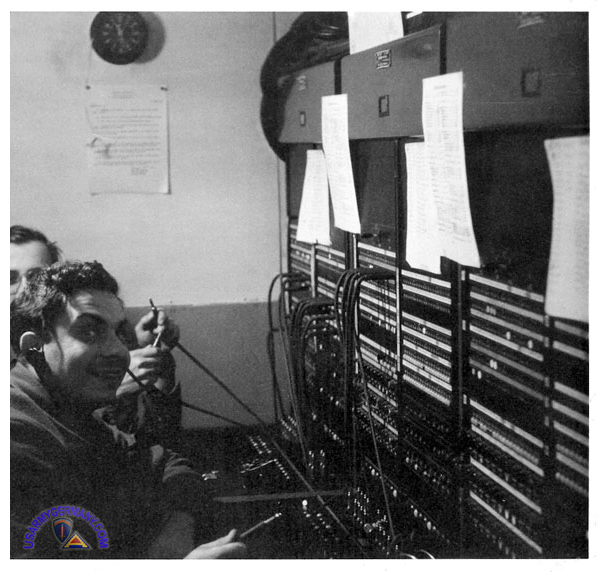 32nd Sig Bn used the same type of 3-position switchboard as this one from the 97th Sig Bn |
||||||||||||||||||||||||||||||||||||||||||||||||||||||||||||
| (Source: Email from Robert Long) | ||||||||||||||||||||||||||||||||||||||||||||||||||||||||||||
| I took my training at Fort Gorden, Augusta, Georgia. Training was right on very good.
I was assigned to the 32nd Signal Bn as a switchboard operator and stationed at Darmstadt in 1960. The sergeants were Sgt Black & Sgt Young. In garrison we were Victor Base and in the field we were Victor Switch. The switchboards were the same on base as in the field and also the same at Gibbs (just like the one in the photo above). The switchboards in the field were installed in the front of 18 wheeler trailers. The linemem would bring telephone lines to the guys in back of the trailer I believe. There were three of them (switchboards). We went on maneuvers on Winter Shield 1 and Winter Shield 2. While we were in garrison, the 18 wheeler was kept in the motor pool on base. I was in Darmstadt for about a year then went TDY to Gibbs in Frankfurt. I worked at the IG Farben complex up on the 7th floor. Our switch boards were along side the German civilian switchboards. We had to ride the strassenbahn to get to work from Gibbs. On base (Gibbs) there was a german civilian in the back room to take care of the mainframe for our boards. . When we had guard duty, if you were outstanding in your appearance, spitshined boots, clothes neat, etc the CO would dismiss you from guard duty and you would get a 2-day pass. I don't remember the name of the building but like the others we had a German tailor downstairs. There was a pizza place outside the fence that we used to order and they would bring it to the fence. We had a barber shop on base. EM club - at the EM club we would see great entertainment. Lose money to the one armed bandits (slot machines). Always stood in a long line to eat (at the mess hall). Food was great though. We used to eat at different mess halls just to check them out to see if the food was better or not. The was a transit mess hall by the IG Farben building along with others. Air Force also had one in Darmstadt At the IG Farben, when we first arrived at Gibbs, we were told to tell the tram conductor where we wanted to go. We would say I G Hochhaus. All I remember about the 7th floor (IG Farben Bldg) is where I worked, nothing else. I was a 19 year old kid just going to work. Worked one day and you got one day off; worked two days got two days off; worked three days and you got three off. It was a good job. Throw in a two day pass and you could take a vacation. From there I was at the end of my enlistment leaving as a short timer in Oct 1962. |
||||||||||||||||||||||||||||||||||||||||||||||||||||||||||||
| (Source: GUARDIAN, Aug 27, 1960 - submitted by Tom Senuta) | ||||||||||||||||||||||||||||||||||||||||||||||||||||||||||||
| Operation 'Broadcast' - The Voice of Command Text by Sp4 Kenneth R. Miller; Photos by Sp4 Huey E. Nichlos In an age of missiles and machines, communication systems provided by Army signal units have become increasingly important in extending the "voice of command" necessary to control the combat elements of the Modern Army. There is, however, a problem involved, the systems must be born dependable and mobile. One solution to this problem in V Corps is provided by the 32d Signal Battalion's VHF (Very High Frequency) Radio Platoon. This platoon, with its highly trained men and expensive 2½ -ton truck-mounted radio equipment, provides the backbone of Corps field communications. The Seventh Army-wide Signal Field Exercise "Broadcast" provided valuable training for Lt Harlon F. Peterson's platoon in field communication skills. The problem began with an alert. Men scrambled for their trucks, and convoys were soon headed for the battalion's various assembly areas. From the assembly areas, VHF teams were dispatched to field locations which would soon be transformed into operating VHF sites. After arrival at the sites, trucks were positioned and equipment unloaded. VHF team members, each with a job to do, began the exacting job of contacting other sites and lining up equipment. Line crews from the battalion's construction companies connected the vans with carrier equipment in the Command Post area some distance away. From the carrier vans the wires were strung to telephone switchboards and teletype machines, and if everything went well, the system was in business. Keeping the equipment lined up and operating smoothly requires patience, but the operators can relax a little. The pressure diminishes until the team is ordered to "jump" to a new position, and the process of establishing and maintaining the system begins again. Despite the long hours of concentrated effort often required, the work is not without compensation: pride in a job well done. And the work is not without its purpose: extending the "voice of command." (Also, see Tom's email on his service with the 16th AOD in the late 1950s) |
||||||||||||||||||||||||||||||||||||||||||||||||||||||||||||
|
||||||||||||||||||||||||||||||||||||||||||||||||||||||||||||
| (Source: Photo album from unknown member of Co E, 32nd Sig Bn, early 1960s) | ||||||||||||||||||||||||||||||||||||||||||||||||||||||||||||
| Photos displayed below are from a photo album of an unidentified member of the 32nd Signal Bn and appear to have been taken in the 1960-61 timeframe. Anybody with information pertaining to the photos - kaserne, personnel, equipment or events - please contact me |
||||||||||||||||||||||||||||||||||||||||||||||||||||||||||||
|
||||||||||||||||||||||||||||||||||||||||||||||||||||||||||||
| (Source: Email from Ray Roberston) | ||||||||||||||||||||||||||||||||||||||||||||||||||||||||||||
| I served in D Co., 32nd Signal Battalion from 1960 to 1962 as a radio teletype operator and as company armourer. As I remember we
were in Gibbs Barracks in Frankfurt before moving to Cambrai Fritsch Kaserne in Darmstadt. I joined the Army in 1958. I did basic training at Fort Dix, NJ. The barracks were WWII temporary buildings. The heating system leaked so bad that we didn't use it. We preferred the cold to the smoke. The walls had cracks large enough that when it snowed we woke up with snow on the floor. Next the Army sent me to Ft Devens to radio direction finding school (MOS 059) with the Army Security Agency. More WWII barracks but at least the heat worked. We used to supplement our $77 per month pay by picking apples at $.10 per bushel. I could make $40 on a good week end. The school lasted almost a year and graduated top in my class. After spending all that time and money on my education, the Army in their infinite wisdom sent me to Germany to be a radio teletype operator. This was a job for which I had no training, but not much was needed. I was assigned to D Company, 32nd Signal Bn. More WWII barracks, but these were German and far superior to the ones stateside. But still the same double deck bunks, with 2" thick mattress, and the scratchy OD wool blankets. A welcome relief was no more KP (Kitchen Police), this was handled by German nationals. We also got 2 16" lockers. One was military, one civilian that was not subject to neatness inspection, only to an occasional shakedown inspection. The 32nd had 4 main missions. Pole line companies that strung WD4 to connect the EE8 field phones, armed courier service, land line teletype service, and mobile radio teletype service. I was the latter. We used deuce and a half's (2.5 ton trucks) with a radio van permently affixed with a 10 KW gas generator in a pull behind trailer. The equipment in the van was WWII vintage, BC610 400 watt transmitter, a pair of R388 radios, a FSK modem, and 50 baud Baudot teletypes. When you consider that the Baudot code is 5 bits as opposed to 8 bit ASCII, this corresponds to less than 32 bytes per minute. My present 3 mbit internet service delivers 20 megabytes per minute, or about a half a million times faster. The truck full of equipment would fit in a suitcase. While in the ASA Morse intercept school I had met some people who could send and receive Morse code at over 50 WPM, equivalent to all the sophisticated equipment in the truck. In fact I meet one individual who could receive Morse code at 90 WPM while smoking a cigar and reading a book. Some of the TTY operators claimed they knew people who could decipher the 50 baud FSK signal. I only got up to 35 WPM in Morse. While I could certainly decipher the RYRY test signal and some others I never learned to decode Baudot in my head. In garrison our mission was to keep a network up and running by passing test messages once an hour. We were net control with some infantry and armored divisions completing the rest of the net. Being low man on the totem pole I got the night shift. The radio operators from the infantry and armored divisions were not dedicated operators, but EM with other duties. After working all day they tended to nap on the night shift so a lot of test messages were logged on the landline after the fact. Every winter we did training. FTX (Field Training exercise) Winter Shield was one. We got in our trucks and drove a few hours to somewhere in southern Germany. We set up in the woods next to some farmers tree plantation. Setting the camouflage nets up over the trucks in the snow was a physically challenging duty. Then I had to dig an area to set up my tent. At least I had the assistance of the air brakes on the trucks to blow up my air mattress. The sergeants got to sleep in the trucks. The generator had enough power to run the electric heaters in the radio van, but not enough for the tent. When we left the tree farmers inspected the area and were compensated for every tree that was run over for the total value that tree would have obtained over its expected lifetime. I was interested in electronics and radio as a hobby also. I used to fix the electronic equipment of the newcomers who plugged stuff into the 220 volt circuits without using a step down transformer. I obtained a German ham radio license (DL5BL). I also became a MARS (Military Affiliate Radio Service) operator. They gave me a SP600 receiver and a Rosen Swartz transmitter. The receiver was American; the transmitter was captured WWII equipment. The SP600 was on par with the R388; the transmitter was equivalent to the BC610 but much better built. It was all neatly built in a 5 foot tall relay rack with each of the individual modules easily serviceable. The power resistors were a work of art made by Rosenthal. In spite of my interest in radio and electronics the Army in their infinite wisdom decided to make me company armourer. This is another occupation for which I had no training. After leaving the Army I became an Electronic Engineer, so the former MOS was more suitable for me. As armourer I was in charge of the "gun room". I had to check out guns to three EM going on guard duty, check in the three from guards coming off shift, and issue one to the armed courier who drove down to the IG Farben building every morning. In the afternoon the courier returned his weapon. This totaled about a half hour's work per day and I had an assistant who did the afternoon "work". Since I was on duty during critical times I was exempt from formations. On the next FTX my job was to see that there was enough diesel fuel for the stove in the headquarters tent. The sergeant major liked comfort on his camping trips. This was more comfortable than the pup tent. In addition to the routine duties I had to issue the weapons once a month for cleaning, issue weapons for training exercises and once I had to issue the guns in anger. This was the time when the Berlin wall was erected. We had a president who was receiving OJT (On the Job Training) as an international diplomat and was failing miserably with the Russians. So one day I gave the guns out so our guys could stare at the Russians in East Germany, who were staring back and probably just as interested in not starting anything as our guys were. This was the same time that we had a large influx of Reservist's on base that were very unhappy that their careers as civilians were being unfairly interrupted. The guns I took care of were mostly M1 and M2 carbines and M1 Garrand rifles. There were a 6 M1911 45 caliber pistols, 4 Bazookas (3.5 inch shoulder fired rocket), 4 50 caliber machine guns, and 6 grease guns (45 Caliber hand held sub machine gun). Some of these guns saw service in WWII. It was interesting to see the difference in the quality of the weapons that seem to depend mainly on who made them. The Rockola (a juke box manufacturer) carbines were rough and ill fitting, IBM turned out a quality product. One of the Garrands had a serial number 1187 which made it among the very first to be manufactured. It was a work of art, and I managed to issue it to someone who had an appreciation of weapons. The Bazooka were fun to fire, the 50 cal MG was awesome to fire with every fifth round being a tracer. It was also a challenge to take apart for cleaning and to reassemble it. My personal favorite was the grease gun for its amazing simplicity and function. It was also nice because if you left the bolt in the gun room it was the lightest. The bolt was probably about one third of its total weight. The biggest morale booster on base was the USO club. They had a double deck pinochle tournament once a week. It drew about 20 teams every week. I had a particularly good partner, a master sergeant; we won the tournament 14 out of 16 weeks. They sponsored bus trips most weekends to nearby towns, to castles, wine festivals, museums, etc. The cost of the round trip transportation was $.25. It provided an environment that was much more home like than the barracks. I was sad to see the USO eliminated, probably some cost cutting measure by the OJT president. The other entertainment for the GI's was the EM club, which had booze for $.25 per mixed drink, good German beer for as little as $.05 on nickel beer night (Friday). They also had slot machines at which I was lucky and managed to win a couple of dollars. They were the ruin of some others. They occasionally had live entertainment from the states. Another favorite among some of the GI's was 20 mark alley (4.20 marks to the dollar = $4.67) near the Frankfurt Bonnhoff. This was practically popular on payday. Payday was the best day of the month to eat in the mess hall because very few GI's were left for the evening meal and they had very good steaks. Good food was in short supply so that was the only day when there was enough supply to meet demand. While in Europe I did some traveling while on leave. On one trip four of us visited Austria, Switzerland, and Italy. We had wanted to do France, but the whole country was "Off Limits" to GI's due to the Algerian crisis. As a guide book we used Frommers "Europe on $5 a day". We weren't sure if that was for each of us or for all of us. We averaged $3 or 4 each. SP4 Powers had a small British car, I think a Morris Minor. It was a tight fit but we had a good time. At that time the Germans liked the Americans fairly well. The rest of the countries we were treated with emotions that ranged from indifference to outright hostility. I am not sure if we, who were all just past being teenagers, did much to endear ourselves to the locals. The worst German / American incident I can remember is the night when some GI got drunk and decided to drive his tank downtown. The Army experience was an interesting one. I was not a particular sharp soldier. I managed to keep out of trouble, but was never recommended for promotion. As a result I was the highest ranking PFC in the company with 32 months time in grade as a PFC. My final salary was $125 a day, once a month. I am glad I went through it but I am not sure if you could pay me enough to do it again. It taught me about how people operate and that the Army was not my career choice. This motivated me enough that I was able to do very well in college. I have a number of color slides that I took while stationed in Germany that I have digitized if you are interested. |
||||||||||||||||||||||||||||||||||||||||||||||||||||||||||||
|
||||||||||||||||||||||||||||||||||||||||||||||||||||||||||||
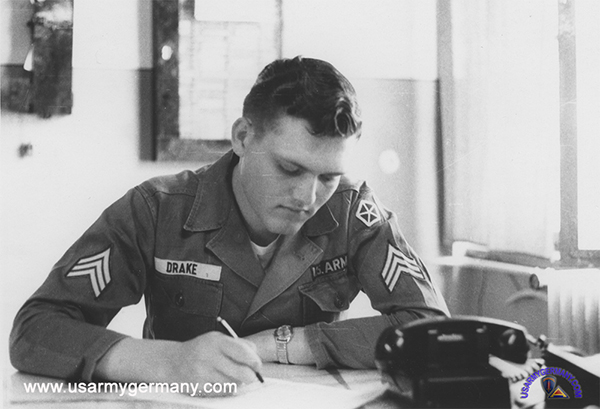 SGT Earl Drake at his desk, Babenhausen Kaserne, 1966 |
||||||||||||||||||||||||||||||||||||||||||||||||||||||||||||
| 1964 | ||||||||||||||||||||||||||||||||||||||||||||||||||||||||||||
| (Source: Email from Earl Drake) | ||||||||||||||||||||||||||||||||||||||||||||||||||||||||||||
| Although I was assigned to Company E, 32nd Signal Battalion, I never spend a night or a full day at the unit in McNair Kaserne in Höchst, Germany. I was always attached to other units. Most of my time it was the Headquarters and Headquarters Battery, 36th Artillery Group in Babenhausen, but also Her Majesty’s The Queen’s 12th Royal Artillery in Recklinghausen (6 months, for preparation for and during Operation Winter Express). I also taught for 6 months at the Signal School in Lenggries, then taught and was attached for 4 months to the 10th Special Forces Group in Bad Tolz. I had a wonderful tour of duty for my 3 years in Germany, even if I was extended for 6 months back at the 36th for “no replacement available” (I was the Section Chief of UHF/VHF/Carrier Section.). I was in Babenhausen, Germany just after the Army had closed and sold the Babenhausen Kaserne. I have some pictures I took then, if you would like copies of them. I could not get access, so I had to take the pictures from outside through the fences. I have maintained a friendship with several German friends through the years. If I had to pay for hotel rooms, I could not afford to travel around Germany. Several of my German friends have been able to travel to the United States and they stay with me, my friends and relatives, so they can afford to travel to the U.S. When I was there during my last visit, I was presented a picture of me in the 32nd Signal Section Room at HQ & HQ Btry, 36th Arty Gp in 1966. I did not know the picture even existed. Once a year, we (Babenhausen Kaserne) had an Open House for military dependents and the German citizens of Babenhausen. While waiting for our visitors to arrive, I was doing paper work when a German friend arrived and took this picture (above). I did not know he was there until the flash went off. |
||||||||||||||||||||||||||||||||||||||||||||||||||||||||||||
| 1966 | ||||||||||||||||||||||||||||||||||||||||||||||||||||||||||||
| (Source: Email from Garry Terrell. Garry lived in Hoechst as an Army brat in the 1980s and attaended Frankfurt American High School during that time frame) | ||||||||||||||||||||||||||||||||||||||||||||||||||||||||||||
| Some of these photos were during the German American Day festivities held at
the McNair (Frankfurt Milcom) ball field on 14 May 1966. The names of the brass shown in some of the photos include: |
||||||||||||||||||||||||||||||||||||||||||||||||||||||||||||
|
||||||||||||||||||||||||||||||||||||||||||||||||||||||||||||
| 1978 | ||||||||||||||||||||||||||||||||||||||||||||||||||||||||||||
| (Source: Email from William R Meaney, HHC, 32nd Sig Bn, 1978) | ||||||||||||||||||||||||||||||||||||||||||||||||||||||||||||
| I was stationed at McNair Kaserne with C Co, 32nd Sig Bn and HHC, 32nd Sig Bn from 1974-1978. In 1978 I rotated back to the States for 18 months and then returned to the same job at HHC, 32nd Sig Bn in May of 1980. I was with the Battalion when it reorganized into the 22nd Signal Brigade. Also served with 19th MMC, 3rd SUPCOM, at Gibbs Bks, Frankfurt (Sept 1981-March 1983) and Wiesbaden AB (March 1983 - August 1988). I was the NCOIC of HHC Engineer Shop. I was an Sp/5 52D30 generator mechanic. During all major field exercises, all of the generator mechanics in the Bn fell under my control. We provided maintenance, and back up support for HQ V Corps and the Bn/Bde. The 32nd Sig Bn consisted of A, B, C, D, 17th and 201st Signal Companies. It was the largest signal battalion in the US Army at the time. We provided communications for V Corps. (Webmaster note: Companies A, B and the 201st were command operations companies that provided tactical communications facilities for Corps Headquarters at main, alternate and SUPCOM respectively. Co "C" was the command radio relay and cable company, providing multichannel communications between echelons of V Corps Headquarters and headquarters of the Corps' major subordinate commands. Co "D" was the corps artillery radio relay company and provided multichannel commo between V Corps Headquarters and the V Corps artillery groups as well as the corps tactical command post.) The Battalion had numerous types of communications vans; 1.5KW through 100KW power generating equipment; 5, 10, and 100KW utility power transformers; and the usual military wheeled vehicles. The 201st Signal Company was partly located in the Abrams Building at V Corps HQ and provided inter-corps and theater commo; the Rear element at McNair Kaserne provided back up. The 17th Signal (Detachment) was located somewhere in Darmstadt with a back up element at McNnair. They provided high security commo. The pictures I took (see below) were taken in the middle of REFORGER 78 (Aug-Oct 1978). I rotated to the States in the second half of REFORGER. |
||||||||||||||||||||||||||||||||||||||||||||||||||||||||||||
|
||||||||||||||||||||||||||||||||||||||||||||||||||||||||||||
|
||||||||||||||||||||||||||||||||||||||||||||||||||||||||||||
| 1982 | ||||||||||||||||||||||||||||||||||||||||||||||||||||||||||||
| (Source: Email from Michael S. Cunningham, Bravo Co, 32nd Sig Batt., 1982-84) | ||||||||||||||||||||||||||||||||||||||||||||||||||||||||||||
| The site brought
back a lot of memories. I was there from June 1982 to Sept 84. I was
in Bravo Co. 32nd Sig. We were at McNair. I guess from what I read
they are not there anymore? Is this true and if so what do they do
with that building now? I was a light wheel, generator mechanic there, so we worked down the street from the actual barracks. I can remember the first time I got there and thought "Oh my god, they sent me to prison," because that's what it looked like. But I got to love the place over time and had a great time there. I was wondering if you get any mail from other people who were there at the same time I was? If you ever hear from anyone else from Bravo Company I would love to hear from them. Thanks a lot. You brought back a lot of great memories. Michael Cunningham |
||||||||||||||||||||||||||||||||||||||||||||||||||||||||||||
|
|
||||||||||||||||||||||||||||||||||||||||||||||||||||||||||||
| 201st Signal Company | ||||||||||||||||||||||||||||||||||||||||||||||||||||||||||||
| 1971-73 | ||||||||||||||||||||||||||||||||||||||||||||||||||||||||||||
| (Source: Email from George Lopez, 201st Sig Co, 1971-73) | ||||||||||||||||||||||||||||||||||||||||||||||||||||||||||||
|
||||||||||||||||||||||||||||||||||||||||||||||||||||||||||||
| Each trip out of McNair we would drive directly to the outskirts of Rhein Main Air Base, and set up shop. Nowadays, the area has been off limits since a lot of the terrain has been destroyed from all the years of the military going there. During the rest of the time was spent working at the motor pool, making sure all the vechicles were up to par. I remember I got pulled over by some MP's to check out my truck and was awarded a letter of commendation for not getting any strikes, by my CO in formation soon after. I would also like to let everybody know that my late father, who just passed away this April was a decorated WWII soldier, who saw action in the North Africa and Silicy campaigns. He was wounded before D-Day and missed out on the action. I have copies of his DD214 and he was awarded seven medals. |
||||||||||||||||||||||||||||||||||||||||||||||||||||||||||||
|
||||||||||||||||||||||||||||||||||||||||||||||||||||||||||||
| (Source: USAREUR STATION LIST, 30 Dep 1971) | ||||||||||||||||||||||||||||||||||||||||||||||||||||||||||||
| 201st Signal Operations Company (Medium Headquarters), MTOE 11-127G, Höchst, APO 09757 The 201st Signal Company provided communications support to the V Corps Support Command. (Another signal operations company on the VII Corps side, the 472nd Signal Company at Nellingen, provided similar communications support to VII COSCOM. This unit was attached to the 34th Sig Bn.) |
||||||||||||||||||||||||||||||||||||||||||||||||||||||||||||
| Related Links: 32nd Signal Battalion - official website of the active unit in Germany McNair Kaserne - Late 1970s - Doug Otoupal's website dedicated to his tour with the 32nd Sig bn at McNair Kaserne |
||||||||||||||||||||||||||||||||||||||||||||||||||||||||||||
